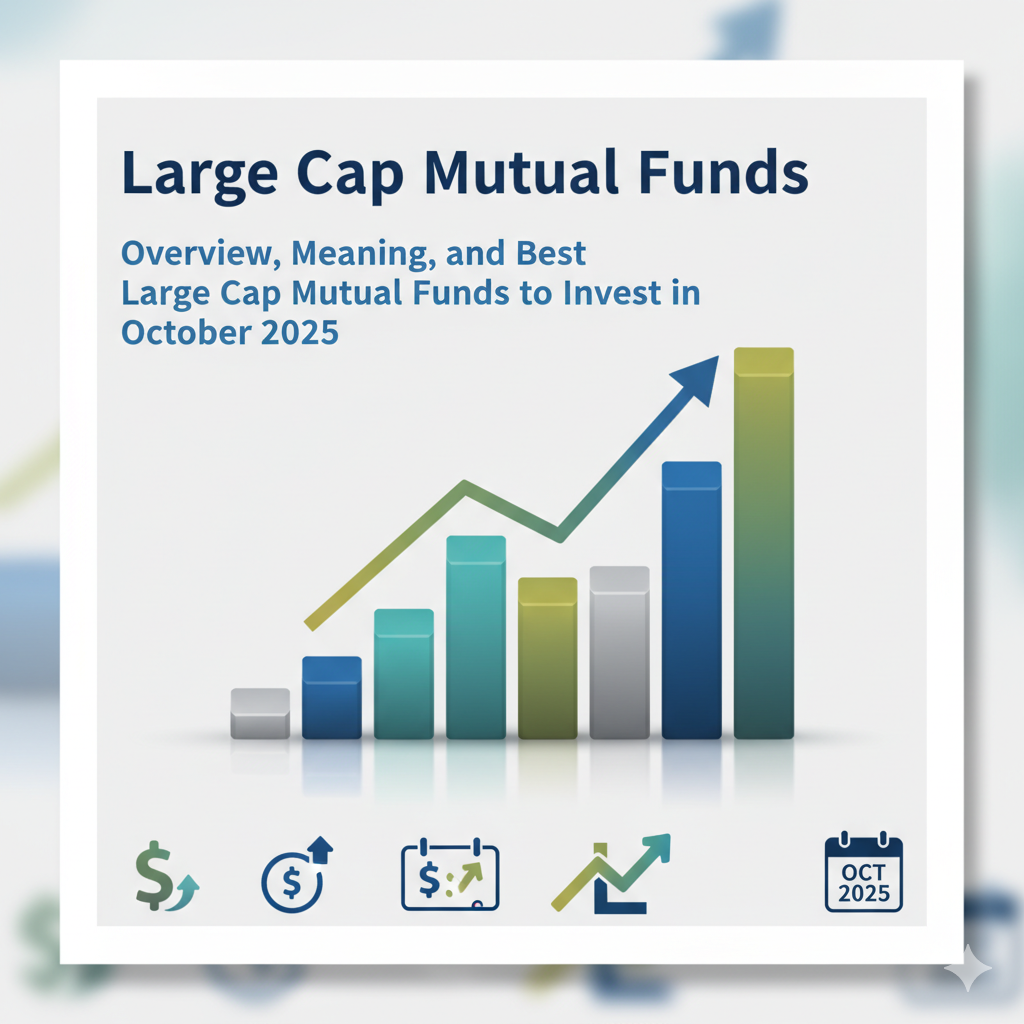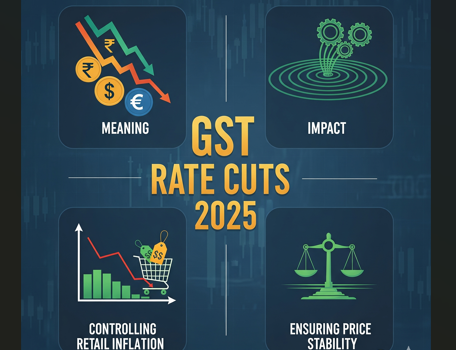Several mutual fund advisors are suggesting investments in large cap schemes for the current financial year. They believe this category could perform well as markets move into an overvalued zone. According to them, with the stock market at record highs and expected volatility ahead, conservative investors seeking relatively safer equity options for long-term goals should consider large cap mutual funds.
As per SEBI’s guidelines, large cap mutual funds must invest in the top 100 companies based on market capitalisation. These companies, often market leaders, tend to perform better during volatile phases due to their stability and resilience. Therefore, investors seeking a relatively safer mutual fund option should consider large-cap funds.
In this Blog, we will look closely at and understand the concept of Large Cap mutual Funds and which are the best Large Cap Mutual Funds to invest in October 2025.
What are Large Cap Mutual funds?
The term “large cap” describes companies with high market capitalisation. In India, SEBI defines large-cap companies as the top 100 firms by full market capitalisation. In simple terms, market capitalisation = (total shares outstanding) × (current share price). Globally, companies with a market cap exceeding US$10 billion are typically classified as large caps, though this threshold can vary across markets.
Large-cap mutual funds are equity schemes that invest a major portion, usually 80% or more of their assets in these large, well-established companies. Such funds are often regarded as core equity investments, offering market exposure with relatively lower volatility compared to mid-cap or small-cap funds.
Best large cap mutual funds to invest in October 2025:
1. Axis Large Cap Fund
History and Overview
| Particulars | Revised Details |
|---|---|
| Fund Name | Axis Large Cap Fund |
| Inception Date | 11 November 2009 |
| Previous Name | Known earlier as Axis Bluechip Fund, renamed in June 2025 |
| Asset Management Company (AMC) | Managed by Axis Asset Management Company Ltd. |
| Fund Objective | To achieve long-term capital growth by investing primarily in large-cap equity stocks |
| Benchmark Index | BSE 100 Total Return Index (TRI) |
| Equity Allocation | Invests 80–90% of its corpus in the top 100 large-cap companies based on market capitalisation |
| Assets Under Management (AUM) | Approximately ₹33,000 crore as of mid-2025 |
| Expense Ratio | Around 1.5% for the Regular Plan |
| Fund Manager | Managed by Shreyash Devalkar since November 2016 |
| Historical Returns | Delivers about 12–14% CAGR over the long term |
| Risk Category | Categorised as Very High Risk under SEBI’s classification |
| Ideal For | Suitable for long-term or conservative investors seeking steady equity growth with lower volatility |
2. Canara Robeco Large Cap Fund
History and Overview
| Particulars | Revised Details |
|---|---|
| Fund Name | Canara Robeco Large Cap Fund |
| Inception Date | 20 August 2010 |
| Previous Name | Earlier known as Canara Robeco Bluechip Equity Fund |
| Asset Management Company (AMC) | Managed by Canara Robeco Asset Management Company Ltd. |
| Fund Objective | Aims to achieve long-term wealth creation by investing predominantly in financially strong large-cap companies |
| Benchmark Index | BSE 100 Total Return Index (TRI) |
| Equity Allocation | Allocates 80–100% to large-cap equities; may invest up to 20% in other equities or short-term money market instruments |
| Assets Under Management (AUM) | Approximately ₹16,280 crore as of August–September 2025 |
| Expense Ratio | Around 1.64%–1.65% for the Regular Plan |
| Fund Managers | Managed by Shridatta Bhandwaldar and Vishal Mishra |
| Historical Performance | Delivers ~12.8% CAGR since inception; 17–18% over 5 years; 15–16% over 3 years |
| Risk Category | Classified as Very High Risk under SEBI’s guidelines |
| Minimum Investment Amount | SIP starts from ₹1,000; lump-sum investment from ₹5,000 |
| Exit Load Structure | 1% applicable if redeemed within one year; no charge thereafter |
| Ideal For | Best suited for long-term investors seeking steady returns and exposure to leading, stable large-cap companies |
3. Mirae Asset Large Cap Fund
History and Overview
| Particulars | Revised Details |
|---|---|
| Fund Name | Mirae Asset Large Cap Fund |
| Launch / Allotment Date | Introduced on 4 April 2008 |
| Fund House | Managed by Mirae Asset Mutual Fund |
| Objective | Aims to deliver long-term capital appreciation by investing mainly in large-cap companies with strong fundamentals and leadership positions in their sectors. |
| Benchmark | Tracks the Nifty 100 Total Return Index (TRI) for performance comparison. |
| Investment Allocation | Allocates 80% or more to large-cap equities and the rest to other equities or related instruments for diversification. |
| Assets Under Management (AUM) | Approximately ₹39,400 – ₹39,500 crore as of late 2025. |
| Fund Manager | Managed by Gaurav Misra. |
| Expense Ratio | Around 0.55% for the Direct Plan (as of August 2025). |
| Minimum Investment | SIP starts from ₹99, and lump-sum investments begin at ₹5,000. |
| Risk Level | Classified as Very High under SEBI’s riskometer. |
| Recent / 3–5 Year Returns | Delivered a 5-year CAGR of about 16–17%, with consistent 3-year returns. |
| Exit Load | 1% charge applies if redeemed within 1 year, and no load thereafter. |
| Suitability | Ideal for investors aiming for steady, long-term equity growth and ready to handle market volatility for higher potential gains. |
4. Baroda BNP Paribas Large Cap Fund
History and Overview
| Particulars | Revised Details |
|---|---|
| Fund Name | Baroda BNP Paribas Large Cap Fund |
| Launch Date | Regular Plan: 23 September 2004 Direct Plan: 1 January 2013 |
| Fund House | Managed by Baroda BNP Paribas Mutual Fund |
| Objective | Aims to generate long-term capital growth by primarily investing in large-cap companies with strong fundamentals. |
| Benchmark | Nifty 100 Total Return Index (TRI) |
| Investment Allocation | Allocates at least 80% to large-cap equities, with up to 20% in other equities or related instruments for diversification. |
| Assets Under Management (AUM) | Regular Plan: ₹2,646 crore Direct Plan: ₹47,850 crore (as of 3 October 2025) |
| Expense Ratio | Regular Plan: 1.97% Direct Plan: 0.76% (as of 31 August 2025) |
| Fund Managers | Regular Plan: Jitendra Sriram (since 16 June 2022), Kushant Arora (since 21 October 2024) Direct Plan: Abhijeet Dey, Karthikraj Lakshmanan |
| Recent Returns | Regular Plan: 3-year CAGR 16.86%, 5-year CAGR 18.23% Direct Plan: 3-year CAGR 17.73%, 5-year CAGR 19.59% |
| Risk Level | Very High (as per SEBI’s riskometer) |
| Minimum Investment | Regular & Direct Plan: ₹5,000 lump sum; SIP starts at ₹500 |
| Exit Load | 1% if redeemed within 30 days; no charge thereafter |
| Investor Suitability | Suitable for investors seeking long-term capital appreciation through large-cap equities, who are comfortable with high risk |
5. Edelweiss Large Cap Fund
History and Overview
| Particulars | Details |
|---|---|
| Fund Name | Edelweiss Large Cap Fund |
| Launch Date | 1 January 2013 |
| Fund House | Managed by Edelweiss Mutual Fund |
| Objective | Aims to achieve long-term capital growth by primarily investing in large-cap company equities. |
| Benchmark | Nifty 100 Total Return Index (TRI) |
| Investment Allocation | Allocates at least 80% to large-cap stocks; remaining up to 20% in other equities or related instruments. |
| Assets Under Management (AUM) | ₹1,286.66 crore (as of 3 October 2025) |
| Expense Ratio | 0.61% for Direct Plan |
| Fund Managers | Bharat Lahoti & Bhavesh Jain |
| Risk Level | Very High (as per SEBI’s riskometer) |
| Minimum Investment | ₹100 for both lump sum and SIP |
| Exit Load | 1% if redeemed within 90 days; no charge thereafter |
| Recent Returns | 1-Year: -1.81%, 3-Year: 18.36%, 5-Year: 19.92% |
| Investor Suitability | Ideal for investors seeking long-term growth with exposure to large-cap equities and willing to accept higher risk |
Features of Large Cap Mutual Funds
1. Investment Objective – These funds mainly allocate their assets to the top 100 companies by market capitalisation, as outlined by SEBI guidelines.
2. Market Stability and Lower Risk – Since large-cap firms are established industry leaders, these funds tend to be more stable and less volatile compared to mid- and small-cap options.
3. Reliable Performance – Backed by strong fundamentals and proven track records, large-cap funds usually deliver steady, long-term returns.
4. High Liquidity – The underlying stocks are actively traded, providing investors with easy entry and exit opportunities.
5. Suitable for Cautious Investors – Ideal for those who prefer safer equity exposure, these funds appeal to conservative investors seeking a balance between risk and return.
6. Portfolio Diversification – By investing across various sectors and top-performing companies, large-cap funds help spread risk and enhance portfolio balance.
7. Sustained Wealth Growth – Although their returns might lag mid- and small-cap funds during bullish phases, large-cap funds support consistent and sustainable wealth creation over time.
8. Regulatory Discipline – In compliance with SEBI regulations, these schemes invest at least 80% of their corpus in large-cap equities, maintaining a structured and disciplined investment approach.
Who Should Consider Investing in Large Cap Mutual Funds?
Large Cap Mutual Funds are ideal for:
- Investors looking for equity market exposure with relatively lower risk.
- Those with a medium to long-term investment horizon (5+ years) seeking stable, consistent returns rather than aggressive growth.
- Individuals who prefer diversified, professionally managed equity exposure instead of managing individual stocks themselves.
- Portfolios where large-cap funds serve as the core or anchor allocation within the equity segment.
Final Thoughts
Large Cap Mutual Funds combine steady growth prospects with a degree of stability, making them a suitable option for investors looking for core equity exposure. By channeling investments into some of India’s most prominent and well-established companies, these funds offer a dependable path for long-term wealth accumulation while managing risks better than mid- or small-cap investments.







